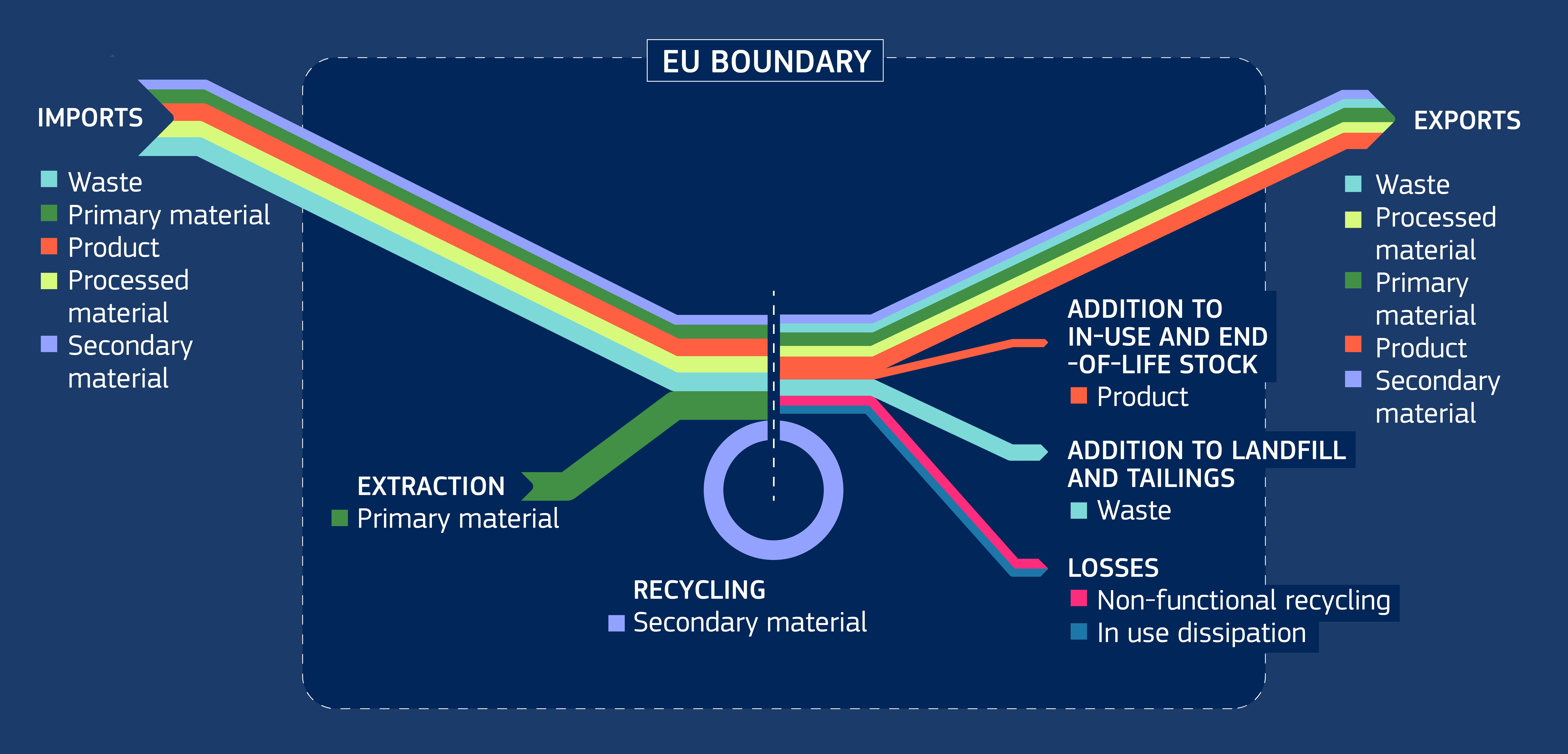A material system analysis (MSA) follows a material through its life in the EU. This helps us to understand its value chain, entry points into the economy, for example as raw materials or as parts of components or products, and whether and how it leaves the EU again.
Material system analysis explained
MSA also gives us relevant information on a raw material’s use and lifetime or volumes imported and exported. Importantly, it also shows
- how much is recycled at end-of-life: the end-of-life recycling rate (EoL-RR)
- how much of the demand for manufacturing these secondary raw materials can satisfy: end-of-life recycling input rate (EoL-RIR)
- how much is kept in in-use or stocks in the EU economy
A secure and sustainable supply of raw materials is the backbone of the green and digital transition and fulfilling the green deal. The MSA are a vital tool for monitoring our security of supply for specific raw materials, as well as their performance in the circular economy.
The European Commission performed the first MSA study in 2015, covering a range of 28 raw materials. These were later complemented by dedicated studies on base metals, battery raw materials, and materials becoming critical after 2014. The initial study was updated and expanded in 2023.
Visualisation of MSA
Picturing the complete value chain of a material provides useful information regarding security of supply, use, societal stocks, recycling, especially the EoL-RIR, and loss, at a specific moment in time.

List of materials with an MSA
MSA exist for the following materials:
Aggregates (2015, 2023)
Aluminium (2018)
Antimony (2015, 2023)
Barytes (2021)
Beryllium (2015, 2023)
Bismuth (2021)
Boron/Borates (2015, 2023)
Chromium (2015, 2023)
Cobalt (2015, 2020)
Coking Coal (2015, 2023)
Copper (2018)
Fluorspar (2015, 2023)
Gallium (2015, 2023)
Germanium (2015, 2023)
Hafnium (2021)
Helium (2021)
Indium (2015, 2023)
Iron (2018)
Lithium (2015, 2023)
Magnesite (2015, 2023)
Magnesium (2023)
Manganese (2015, 2020)
Natural Graphite (2015, 2020)
Natural Rubber (2021)
Nickel (2015, 2020)
Niobium (2015, 2023)
Phosphate Rock (2015, 2023)
Phosphorus (2021)
Platinum Group Metals: Palladium, Platinum, and Rhodium (2015, 2023)
Rare Earth Elements (2015, 2023)
Scandium (2021)
Silicon Metal (2015, 2023)
Strontium (2023)
Titanium (2023)
Tantalum (2021)
Tungsten (2015, 2023)
Vanadium (2021)
Documents
Please note that studies after 2020 refer to the EU-27.
- Material System Analysis of 28 raw materials - Final Report (2015): EN
- Material System Analysis of 28 raw materials - Summary (2015): EN FR DE
- Material System Analysis of 3 raw materials: Aluminium, Copper, Iron (2018): EN
- Revision of the Material System Analyses specifications (2020): EN
- Material System Analysis of 5 Battery Raw Materials: Cobalt, Lithium, Manganese, Natural graphite, Nickel (2020): EN
- Material System Analysis of 9 Raw Materials : Barytes, Bismuth, Hafnium, Helium, Natural Rubber, Phosphorus, Scandium, Tantalum and Vanadium (2021): EN
- Update of the 2015 Material System Analysis - Final Report (2023): EN
- Update of the 2015 Material System Analysis - Summary (2023): EN FR DE
